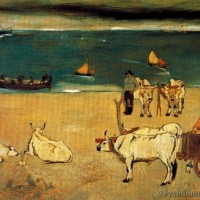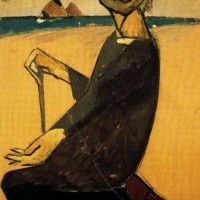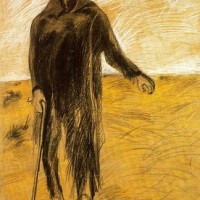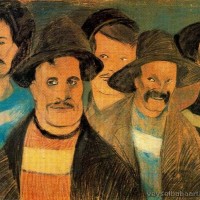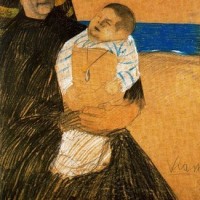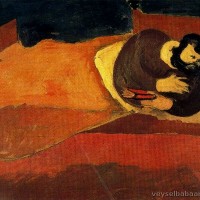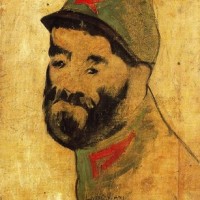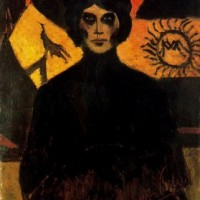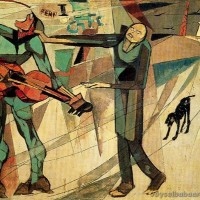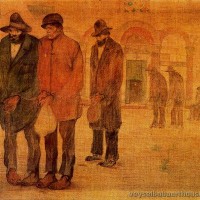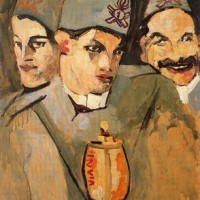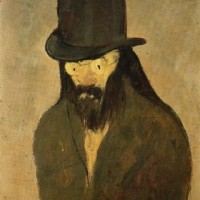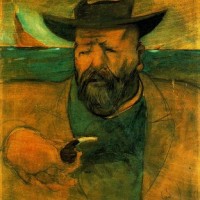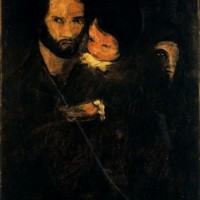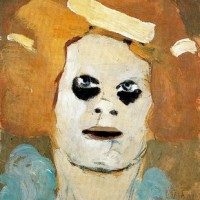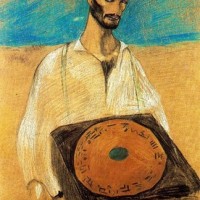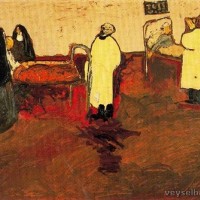- Home
- ABOUT US
- ABOUT VEYSEL BABA
- REDFOX ART HOUSE VIRTUAL TOUR
- MY LAST WILL TESTAMENT
- NOTES ON HUMANITY AND LIFE
- HUMAN BEING IS LIKE A PUZZLE WITH CONTRADICTIONS
- I HAVE A WISH ON BEHALF OF THE HUMANITY
- WE ARE VERY EXHAUSTED AS THE DOOMSDAY IS CLOSER
- NO ROAD IS LONG WITH GOOD COMPANY
- THE ROAD TO A FRIENDS HOUSE IS NEVER LONG
- MY DREAMS 1
- MY DREAMS 2
- GOLDEN WORDS ABOUT POLITICS
- GOLDEN WORDS ABOUT LOVE
- GOLDEN WORDS ABOUT LIFE
- GOLDEN WORDS ABOUT DEATH
- VEYSEL BABA ART WORKS
- SHOREDITCH PARK STORIES
- EXAMPLE LIVES
- ART GALLERY
- BOOK GALLERY
- MUSIC GALLERY
- MOVIE GALLERY
- Featured Article
- Home
- ART GALLERY
- Lorenzo Viani
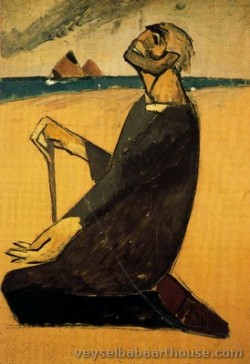
Lorenzo Viani
Lorenzo Viani ( Viareggio , 1 November 1882 - Lido di Ostia , 2 November 1936 ) was a painter , printmaker and writer Italian .
Biography
Lorenzo Viani was born in Viareggio on 1 November in Via della Fornace, now Via Independence, at the old dock [1] . Second son of Emilia Ricci and Rinaldo Viani, the Parish Church of St. Stephen, a small town in the hills of Lucca, had moved to Viareggio, as his father, former servant of the Bourbons in S. Martino in Vignale, it was passed after the death of Maria Teresa Felicita di Savoia (16 July 1876), the pay of Don Carlos, in the royal villa of the east of Viareggio pinewood. A childhood spent between the dock and the Palace; between the poverty of the sailors and shipwrights and superstition of the "rogue" as it was called good-naturedly the servants of the Bourbon, and the lavish pomp of a dynasty in exile. Until the father had this job, the family conditions of Lorenzo were pretty quiet. He attended primary school, but only up to the third class because the school experience stopped for a congenital intolerance to any form of discipline. The worm of anarchy had already crept into the young mind.
When the father was dismissed from the service, the Viani family knew the misery, the human condition that was not unknown to the young Lorenzo, since he, because of his rebellious nature and introspective, he devoted much of his time wandering through the woods and the beach Viareggio dock, which was one daily spectacle of misery and squalor, and, in contact with the "rogue" subservient to the Bourbons, the boy, prematurely marked by the difficulties of life, confessed one day to the mother to be haunted by the thought of death.
In 1893 he is put to work in the Barbershop Fortunato Primo Puccini, where he remained as an apprentice for several years and met prominent figures, such as Leonidas Bissolati , Andrea Costa , Menotti Garibaldi , Giacomo Puccini , Gabriele D'Annunzio and met the painter Plinio Nomellini , which had a positive influence in the artistic development of the boy. He begins to draw with growing interest and a portrait of the musician Giovanni Pacini draws the attention of Viareggio. He embarks on his first exploratory trips to Pisa and Lucca .
Versilia and in other Italian places the class struggle becomes more and more open: agitated crowds, preceded by black flags, invade the village squares, stationed in front of the ovens, shatter the windows. The meeting with the sociologist Pietro Gori and frequent contacts with the Socialists Vico Fiaschi and Luigi Salvatori decide the final accession of Viani to ' anarchy . Sometimes the young man sleeping on the stones of the dock or spend the night at " Casone ", a regular haunt of vagabonds, of refined and free thinkers.
On the advice of Pliny Nomellini, who works at Torre del Lago , he enrolled at the Academy of Fine Arts in Lucca , where he attended about three years of lessons, from 1900 to 1903 , and also knows where Moses Levy and Spartaco Carlini . During this experience Lucca, the Viani did not fail to attend, with other students, in anarchist and socialist demonstrations. In 1904 he was admitted to the Free School of Nude adjoining Academy of Fine Arts in Florence , where he attended courses Calosci and Giovanni Fattori , while continuing to demonstrate a clear intolerance of academic disciplines.
Returned in Viareggio, he moved to Torre del Lago and becomes part of the " Compagnia della Bohème ". Attends Giacomo Puccini , which considers ironically the subjects of his paintings, while Plinio Nomellini instead continues to encourage his artistic research. Miserable room where she works in Torre allows him, as he wrote years later, to anticipate the Parisian experience. In the preparation of the Florentine People he meets the Ligurian poet Ceccardo Roccatagliata Ceccardi , which is looking for recruits for his Republic of Apua , whose members are prominent figures of the early twentieth century, including, in addition to Lorenzo Viani, the writer Enrico Pea and historical and literary lunigianese Pietro Ferrari. Ceccardi he was president, Viani lieutenant.
Viani exposes some drawings at the VII Biennale di Venezia , which, thanks to the review Luigi Campolonghi , start the legend of the painter of horror and misery. During that occasion he discovered the work of Laermans and sympathizes with Umberto Boccioni , participates in the National Exhibition of art humorous Messina and receives the first medal of his life. In November, in Genoa , where he collaborated with satirical drawings to the anticlerical magazine The Catapult , directed by Luigi Campolonghi Illustrates The raft of the same and in the poem in Italian language The rebels of Francesco Muratorio , which is published in the following year. IThis stay Viani mature considerable pictorial orientation.
At the beginning of 1908 he is in Paris , where he was able to visit the retrospective of Van Gogh , held at the Galerie Bernheim-Jeune. After a short stay at home Fleury, arrives at the public dormitory de la Ruche , in rue Dantzig, and began his hard life will be commemorated in Paris ( 1925 ). Viani during this stay he was able to cross, in a fleeting way, even Picasso . In Paris, where it will remain more or less a year, staying long desired it will prove to be fraught with economic difficulties and loneliness, but still positive for the experiences and the known artistic personalities.
Back in Italy, he continues to detest the social gatherings and not start any significant association. In April, the Venice Biennale refuses his works. The economic and psychological conditions of Viani are becoming more worrisome. To go back to Viareggio, is adapting to the demands of a small publisher of music sheets. In June it was back in Viareggio in his old house and starts to attend local anarchists.
In December 1910 the City Council of Viareggio , because of not too prosperous economic conditions, allows you a room of the building of the Customs. At this time should back Customary , the self-portrait now in the Gallery of Modern Art in Florence , and illustrations for Fole and Sion of Enrico Pea , one of the most prominent intellectuals of the " Republic of Apua ". In December 1911 he was back in Paris, where he meets Amilcare Cipriani , Luigi Campolonghi , the patriarch of all anarchists, Alceste De Ambris, Jean Grave , Octave Mirbeau and other exponents of anarchy and international humanitarianism. In this climate it elaborates ten gloomy and painful cartons on the effects of war. A Paris very little remains, until mid-January 1912 , then returned to Italy.
Participates in the activities of the anarcho-socialist Versilia. In February, care with the union Alceste De Ambris the antiwar pamphlet To the glory of war !, Which is printed by the Working Room Parma . The album was censored by official institutions, and he was arrested and imprisoned, but was released thanks to the support of Luigi Salvatori and other friends. In May 1913 he took the floor in a rally against the war and in November took part in the tumultuous event sponsored by the Chamber of Labour of Carrara . Establishing new friendships in the environment futurist " Lacerba ", especially with Giovanni Papini , Giuseppe Ungaretti , Borsi and Ottone Rosai . In February 1915 Viani says Cesare Battisti during a tumultuous rally at the Politeama of Viareggio and exhibits ten woodcuts III to the Roman Secession . Between October and November exhibits, thanks to the support of Franco Ciarlantini , 624 works at the Palace of Milan Auctions. The show starts in a setting of sophistication and receives a warm public and critics. In December, new important staff at Bagno Nettuno of Viareggio, where converge, for the last time, the leaders of the " Republic of Apua ".
In 1916 he is called up for the war, participating in various war efforts and was discharged in 1919 . In these three years, in the few moments of tranquility, it continues unceasingly to draw, paint and illustrate. On March 2, 1919 he married Miss Julia Giorgetti and moved to Montecatini, where his wife works as a primary school teacher. There remains for about two years and then return to Viareggio are of this period the tender portraits of children busy writing and studying.
In 1922, to celebrate the centenary of the death of the English poet Percy Bysshe Shelley (who died in Viareggio), he was commissioned by the Committee for Funeral to commemorate the anniversary. Viani, for the occasion, oversaw the publication of the single number "PB Shelley" which collaborated Alceste De Ambris and Gabriele D'Annunzio.
The old " Republic of Apua " is being replaced a quieter " Army of vàgeri " which Viani is the general. The headquarters of this free association is the Coffee Torricelli, on the waterfront, but the group also attended the " Buonamico ". Begins at the time the series of paintings of Paris. Public in 1925 with critical acclaim, Paris , witness fictionalized his experience at La Ruche. In view of his artistic achievements he received the teaching of ornate Art Institute today Passaglia of Lucca . But Viani is ill-suited to this work, which is pursuing wearily up at the end of 1926 . In the same year he met the young countryman Renato Santini , who becomes his only student. In early 1927 he started working regularly at the BBC , he directs the magazine Versilia Riviera and publishes The vàgeri . II was inaugurated on May 27 in Viareggio the War Memorial for the Fatherland "I Galeottus", performed with the technical collaboration of the sculptor Domenico Rambelli. The work, absolutely innovative and extraordinary expressiveness, provokes discussion and controversy. Some fellow citizens, in order to emphasize the alleged ugliness of the sculptural group, mockingly coming to rename the square where it stands with the name of the Fear Square.
In 1928 public Anjou Water Man (28 illustrations) and Roccatagliata . He exhibits 11 works at the XVI Biennial of Venice and a large selection of his work at Palazzo Paolina of Viareggio. In this exhibition, presented by Margherita Sarfatti , has exposed the Great dormitory , a summa of all glimpsed frequented the Ruche characters. Begin for the first Viani asthma attacks, disease, with ups and downs, not abandon him over and led him to stay in Bagni di Lucca and other weather stations. Just when little happy about his health, becomes an artist known throughout Italy and its exhibitions are place to meet for an educated public and international.
He paints Georgica (or The sea works, of heaven and earth) and publishes the autobiographical novel Back to home , you win, ex aequo with Anselmo Bucci , the Viareggio Prize . Published the autobiographical novel The son of the pastor . Participates with great success at the XVII Biennial of Venice with Georgica and sail . He participates in various Futurist evenings and his staff at Palazzo Paolina in Viareggio is opened by a speech Marinetti .
Viani exhibited in 1931 , at the Quadrennial in Rome , the holy face. A ddirittura Mussolini demonstrates interest in the work and the author. In August, the new solo exhibition at the Neptune plant in Viareggio. In the same year public Versilia, but new asthma attacks him back for short periods in the hospital. He manages with great effort, in 1932 , to publish the Bava , inspired by the exploits of the navigator Viareggio Raffaello Martinelli and to exhibit at the XVIII Biennial of Venice , in Livorno and Viareggio.
In September 1933 a new asthma attack and, because the worsening of the disease, is forced to a long hospitalization at the psychiatric hospital of Maggiano, near Lucca. In early 1934 , in a brief improvement of the disease, returns to manifest never dormant feelings anarchists , arousing the irritation of bundles local and renouncing his greatest aspiration as the honor of the Italian Academy. Work with great fervor to the panels for the railway station of Viareggio, it is present with his staff at the Galleria Ferroni of Florence and the inauguration of the gallery Viani in the house Fossa dell'Abate (today's Lido di Camaiore ), inherited by his wife. The non-poor health prevents him of exposing the XIX Biennial of Venice, Viareggio, Lucca, at the Second Quadrennial in Rome and at the Lyceum of Florence. In 1936 the were commissioned a series of paintings for the College Ostia and, after a hectic work tirelessly for several days, it will not have time to attend the inauguration because struck by a strong asthma attack. On November 2, the day after his 54th birthday, the indomitable and generous vàgero dies in Ostia died of a heart attack. November 3, the body returns to Viareggio in a collective plebiscite of affection and regret.
Viani has been extraordinary and exemplary character of the cultural and intellectual flowering that characterized Versilia, Lucca and riding Lunigiana between the XIX and XX century. Reading some writings of Viani, trying to remember the memories and the atmosphere of a period that saw, in the space of fifty years, the presence in the land of Apua of characters such as Puccini, Catalani, D'Annunzio, Ungaretti, Malaparte, Pea, Repaci, Cancogni, Montale, Carducci, Pascoli, Roccatagliata Ceccardi, Carra and many others.
Activities

Lorenzo Viani has always felt attracted by the poorest and the derelicts, both in childhood than in adulthood. Life and human history of the weakest, Viani transfers it into the canvas, with strong color impressions and with a brushstroke decisive and fast, intense painting, expressive and extremely melancholic. What makes a great teacher Viani, too often forgotten, is the mastery of the coexistence in his works drama and lyricism and poetic grace, to hear the humble commotion in front of the dispossessed. The poverty of artistic means is a choice; the rough painting becomes essential; sobriety an animal instinct in capturing the forms of life of the poor, the hungry, the prison, disease, loneliness, struggle with the countryside or the sea, war, insanity and pain. The narrative work of Viani is a typical example of expressionism dialect. Its origins are in a disordered vision, disturbed from the bottom, which results in an exaggerated deformation of landscapes such as human faces. The writer uses an extraordinary verbal richness, drawn to the bottom dialect Viareggio, the sailing jargon or soldierly or sly, wherever he can get aggravations expressionistic.
II dialect of Versilia and Lucca, so lively in the language Enrico Pea , becomes lyrical fervor in Lorenzo Viani, expressionist painter who begins to become famous in the early thirties. Viani is not alone, in the century literature, where painting and writing go hand in hand, enlightening each other, as in cases of Soffici Luigi Bartolini and Filippo De Pisis , but it is truly unique as his talent as a writer, who took inspiration from ' Impressionism that breathed around the literary magazine La Voce , owes much to the design, he moved to the character and deforming of its business day painter.
By Viani to his way a bit 'provincial refer to "handpiece dell'Apua", which took in Ceccardo Roccatagliata Ceccardi his bishop, and a rough basic civil dispute, little should be expected from the imagination of the writer; conversely, the cut of his prose, visual and often hallucinating, the varied gallery of derelicts and crazy types from him muster on a basis of trustful fraternity, broken in more than one section in the novels Paris Anjou and Water Man that sort of conformist and bourgeois complacency prevalent in certain writings, on which the author wanted to create a small legend, exposing themselves in the front row with stories that today no longer want. This refers especially to autobiographical memories, distributed Drunks ( 1923 ) or The pastor's son ( 1930 ), and in various other books consist of articles (I wrote about three hundred) where graced the Vàgerì, [2] that they are together players in the lexicon of Viani and its ideal tension towards life and adventure. The best day this writer is thus the unintentional successful, as in Anjou ( 1928 ), where the condition of the dwarf, man of the sea and defeated by the very sea, touching day tips allegorical piety. But Viani interested, telling the misery of the place, as later it will be the keys in the shaft ( 1935 ) observation of the asylum, especially the dive in quell'aspro revolt environment, to make an attempt to simply bomb provincial literature and art made by others, defined by the writer with undisguised arrogance "winners" kissed by success.
In 1924 Viani writes Giovannin fearless , version for young readers of the famous story where courage is linked to madness. The writer's version Viareggio permeates some of the earlier writings including those of Straparola, Grimm and Joseph Pitre Brothers, to name a few, creating a more faithful plot to reality. The work of Viani, while not containing typical magical aspects of the story of John, however, traces the milestones of the fairy tale. History tells us that the brave (and crazy) protagonist (John Bianchi) traveling without a policy and when it really turns out the fear (pain), repents and continues to live. History has connotations and references typical of the seafaring life of the beginning of the 900 in Versilia and can be said to be a cross-section of the poor local conditions of that period.
Major works
Narrative
- Ceccardo , Milan, ( 1922 );
- Drunks , Milan ( 1923 );
- John without fear , Florence ( 1924 );
- Paris , Florence, ( 1925 );
- The Vàgeri , Milan ( 1926 );
- Anjou, water man , Milan ( 1928 );
- Back at home , Milan ( 1930 );
- The son of the pastor , Milan ( 1930 );
- Stories of humble Italian , Rome ( 1934 );
- The keys in the shaft , Florence ( 1935 );
- Beard and hair , Florence ( 1939 );
- People of Versilia , Vallecchi publisher Florence ( 1946 );
- Heart of mother , Florence, and Vallecchi. ( 1961 ).
Lorenzo Viani in museums
- Modern and contemporary art gallery in Bergamo
- Modern and contemporary art gallery GAMC of Viareggio
- Pinacoteca Leonidas and Albertina Repaci of Palmi
